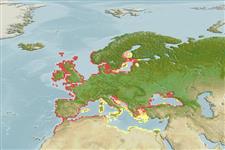Common names from other countries
>
Syngnathiformes (Pipefishes and seahorses) >
Syngnathidae (Pipefishes and seahorses) > Nerophinae
Etymology: Nerophis: Greek, neros, nearos = youhtfull appearance + Greek,ophis = serpent (Ref. 45335).
More on author: Linnaeus.
Environment: milieu / climate zone / depth range / distribution range
Ökologie
seewasser; süßwasser; brackwasser demersal; tiefenbereich 2 - 15 m (Ref. 6733). Temperate; 63°N - 30°N, 11°W - 42°E
Eastern Atlantic: Norway to Morocco (excluding region from Denmark to Netherlands), also throughout the Mediterranean and the Black Sea.
Size / Gewicht / Alter
Maturity: Lm ? range ? - ? cm
Max length : 29.0 cm TL Männchen/unbestimmt; (Ref. 2058); 30.0 cm TL (female)
Anal, caudal and pectoral fins absent (Ref. 59043). Anal opening below front end of the dorsal fin, 28-33 body rings. Has a strait snout (Ref. 35388).
Inhabit algal zone or eel-grass (Zostera) (Ref. 6733). Adults spawn in May - August . Feed on small crustaceans and fish fry (Ref. 35388). Ovoviviparous (Ref. 205). The male carries the eggs in a brood pouch which is found under the tail (Ref. 205). Consistent paternity is ensured despite brooding of embryos on the outside the male's body. Events of cuckoldry by sneaker males is ruled out through genetic paternity analyses based on molecular markers (Ref. 81011). Each male carries eggs from a single female but females may deposit eggs on several brooding pouches (Ref. 81011).
Life cycle and mating behavior
Maturities | Fortpflanzung | Spawnings | Egg(s) | Fecundities | Larven
Consistent paternity is ensured despite brooding of embryos on the outside of the male's body instead of a brood pouch characteristic of the family (Ref. 81011, 53335). Events of cuckoldry by sneaker males is ruled out through genetic paternity analyses based on molecular markers (Ref. 81011). Each male carries eggs from a single female but females may deposit eggs on several brooding pouches (Ref. 81011).
Dawson, C.E., 1986. Syngnathidae. p. 628-639. In P.J.P. Whitehead, M.-L. Bauchot, J.-C. Hureau, J. Nielsen and E. Tortonese (eds.) Fishes of the North-eastern Atlantic and the Mediterranean. Volume 2. Unesco, Paris. (Ref. 6733)
IUCN Rote Liste Status (Ref. 130435)
CITES (Ref. 128078)
Not Evaluated
Bedrohung für Menschen
Harmless
Nutzung durch Menschen
Fischereien: nicht kommerziell
Tools
Zusatzinformationen
Download XML
Internet Quellen
Estimates based on models
Preferred temperature (Ref.
115969): 8.6 - 19.3, mean 13.5 (based on 981 cells).
Phylogenetic diversity index (Ref.
82804): PD
50 = 0.6250 [Uniqueness, from 0.5 = low to 2.0 = high].
Bayesian length-weight: a=0.00085 (0.00032 - 0.00224), b=3.04 (2.81 - 3.27), in cm Total Length, based on LWR estimates for this (Sub)family-body shape (Ref.
93245).
Trophic level (Ref.
69278): 3.5 ±0.47 se; based on food items.
Widerstandsfähigkeit (Ref.
120179): hoch, Verdopplung der Population dauert weniger als 15 Monate. (K=1.05).
Fishing Vulnerability (Ref.
59153): Low vulnerability (17 of 100).
